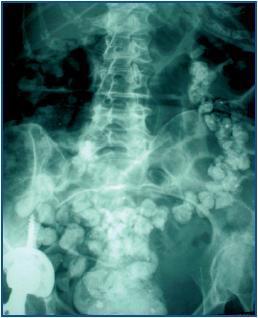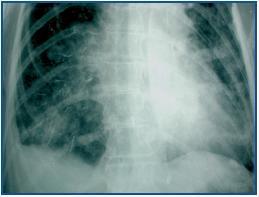Dear Editor,
We report the case of a female patient who suffered from hyperamylasaemia and rectal bleeding, and died unexpectedly owing to a possible bronchoaspiration of lanthanum.
The case involves a 54-year-old female patient with a medical history of hypertension and chronic kidney disease, who had not followed a peritoneal dialysis programme for 8 months, and who was admitted to our department for diarrhoea with hypotension and an episode of rectal bleeding. The abdominal physical examination was irrelevant. The detailed findings showed hyperamylasaemia at around 900U/l (42-220U/l), with leukocytosis levels at 22.1 X 109 l. The other laboratory parameters were at a normal level. The peritoneal fluid was analysed, ruling out peritonitis. An X-ray of the abdomen (figure 1) showed diffuse opacifications in the colon, which corresponded to the lanthanum carbonate tablets introduced 2 months prior to hospitalisation as a treatment for hyperphosphatemia (0.75g oral 3/day). Two colonoscopies were carried out without success, showing a poor level of preparation and blocking the progression of the colonoscope. The presence of a fecaloma impacting on the rectosigmoidal junction was detected in an abdominal computed tomography. There were no signs of pathological masses in the pancreas or the rest of the abdomen. The fecaloma could be extracted; however, on the same day the patient showed signs of sudden dyspnoea and a deterioration of her general state, with hypotension and oxygen desaturation. The thorax X-ray (figure 2) showed radioopaque stripes along the pulmonary alveoli. The patient¿s family was further questioned, confirming the administration of the lanthanum tablets that had been suspended at admission. The patient underwent haemodialysis without any improvement in her pulmonary condition and died.
Lanthanum is a metal prescribed as a captor of aluminium- and calciumfree phosphorus that is visible in the intestine.1-4 Its most frequent side effects include nausea, diarrhoea, hypotension, abdominal pain and constipation;5 however, no symptoms of pancreatitis have been reported in the literature. Our patient probably aspirated lanthanum bronchially, causing her death. Patients treated with lanthanum should be closely monitored owing to the gastrointestinal side effects and their complications.
Figure 1.
Figure 2.









